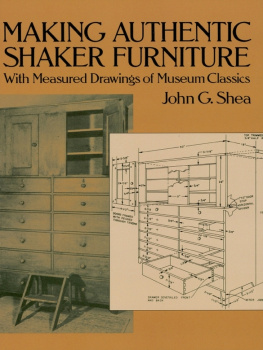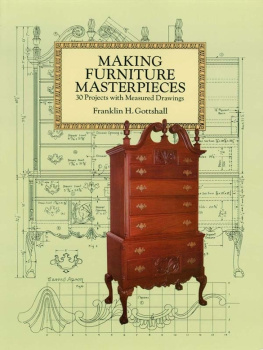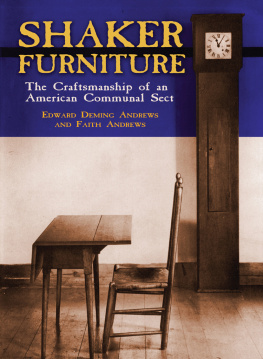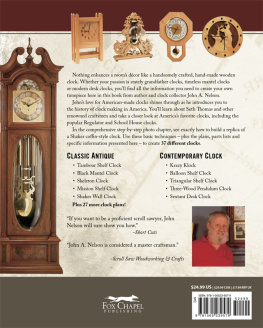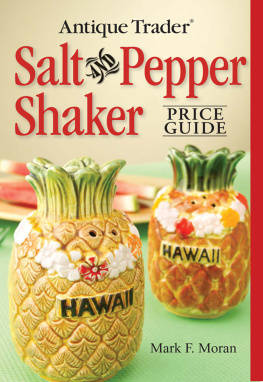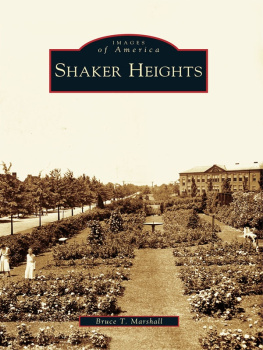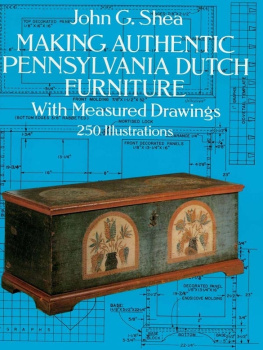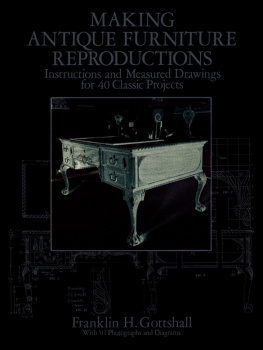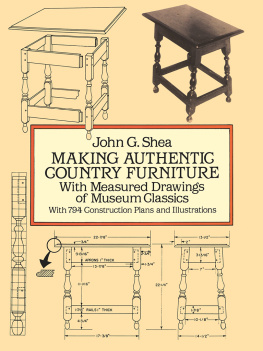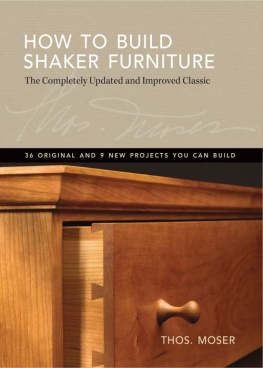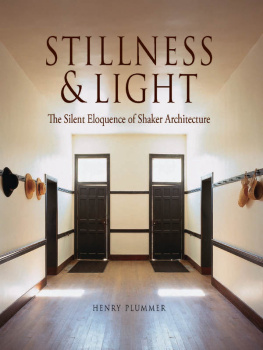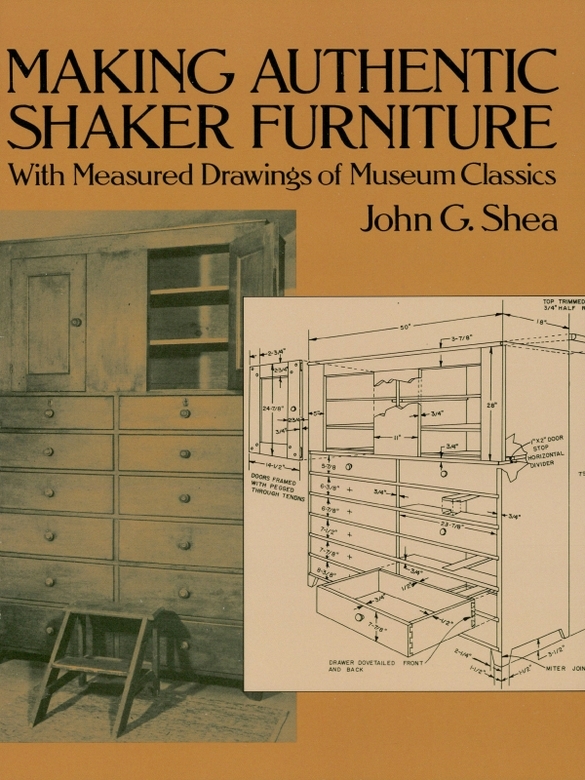ACKNOWLEDGMENTS
My sincere thanks go to the distinguished authors, Shaker authorities, museum curators, and other knowledgeable people with whom I have enjoyed such pleasant and productive relations during the course of Shaker research.
Listed chronologically, in the order of our meeting, my thanks go first to the noted author-historian Mrs. Hazel Spencer Phillips. Along with her excellent books, Mrs. Phillips, who is curator of the Warren County Historical Society Museum at Lebanon, Ohio, has written extensively on the Shakers and has collected their furniture and artifacts from nearby Union Village to form part of her attractive museum displays.
Also at Lebanon, Ohio, I had the pleasure of chatting with Mr. Robert H. Jones, who for many years was the active proprietor of the Golden Lamb Inn Ohios oldest hotel. The Golden Lamb is furnished with many Shaker antiques from Mr. Jones valuable collection. For access to these, my thanks also go to Mr. Jackson B. Reynolds, present director of the Golden Lamb, who was my congenial host and helper during subsequent sessions of furniture measuring and photography.
Later, during a second visit to Ohio and Kentucky, I met Miss Julia Neal, author-director of the Western Kentucky University Museum. Miss Neal, who has written authoritatively on the western Shakers, made documentary material available and described Shaker pieces of the museum collection. During a subsequent visit to the Auburn Shaker Museum, located near the original Shaker community of South Union, Kentucky, I had the privilege of talking with the museum director, Mrs. Curry C. Hall. Mrs. Hall has devoted years to the collection of her extensive museum displays of western Shakeriana. For making available some of his excellent photographs of Shaker furniture, taken at both Kentucky museums, my thanks go to Professor E. Ray Pearson of the Illinois Institute of Technology.
Returning to the east, the first of many visits was made to the Shaker Museum at Old Chatham, New York. There I met its scholarly author-director, Mr. Robert F. W. Meader. Mr. Meaders extensive knowledge of the Shakers was a significant help to me, and I am most grateful to him for making museum facilities available for photography and measurement of the comprehensive and beautifully organized displays of Shaker furniture and artifacts. Also at Old Chatham I had the pleasure of discussing aspects of Shaker life with the knowledgeable and congenial founder of the museum, Mr. John S. Williams. At the same place, I learned much about the Shakers while chatting with Mr. Clarence Williams, who knew them well.
Moving over to Hancock Shaker Village, just across the Massachusetts line from Old Chatham, I met the curator, Dr. Eugene Merrick Dodd, who contributed important information on the life and works of the Hancock Shakers. The friendship of Dr. Dodd is one of the happy rewards of this research and I am most grateful to him for reading and commenting on the first chapter of this book.
At nearby Pittsfield, Massachusetts, I was invited to visit the charming home of Mrs. Edward Deming Andrews. Mrs. Andrews and her late husband, Dr. Edward Deming Andrews, deserve the everlasting thanks of all who are interested in the Shakers. For these dedicated authors devoted decades of their lives to Shaker research and wrote several definitive books on the Shakers. Their private collection of Shaker antiques, which Mrs. Andrews showed me in her home, is augmented by the treasures of Shaker furniture and artifacts that she and Dr. Andrews acquired during their years of research and later made available to museums in this country and abroad.
Over on the other side of Massachusetts, at Harvard, I became a frequent visitor at Fruitlands Museums, which is directed by Mr. William Henry Harrison, great-great-grandson of the ninth President of the United States. Mr. Harrison and his charming wife were most helpful and delightfully hospitable during my many visits to the restored Shirley Shaker House and other interesting exhibits at Fruitlands.
Moving north, into Maine, I visited the Shaker Village at Sabbathday Lake, where I had the privilege of meeting my first real Shaker Sister Mildred Barker. Sister Mildred, a bright and energetic lady, guided me through the exhibits of original Shaker furniture and artifacts, telling me about the history of the community and waiting patiently while I performed my photographic chores. Also at Sabbathday Lake, I am grateful to the master craftsman Mr. Gus Schwerdtfeger for furnishing detailed measurements of typical pieces of Shaker furniture.
My second meeting with living Shakers occurred at Canterbury Shaker Village in New Hampshire. Here I met Eldress Bertha Lindsay, who introduced me to other Shaker sisters. Eldress Bertha and her colleagues all charming and gentle ladies graciously described the historical background of their one-hundred-and-seventy-eight-year-old community and guided my photography of the venerable Shaker buildings and furniture.
As well as the many pleasant contacts made at Shaker communities and adjoining museums, I am also grateful to the directors and curators of national, state, and city museums, who were most cooperative in making information and photographs available. These include Dr. Grose Evans, Curator of the Index of American Design at the National Art Galleries in Washington, D.C.; Mr. Robert Bishop and Mrs. Katherine Hagler of the Department of Decorative Arts at the Henry Ford Museum, Dearborn, Michigan; Mr. John A. H. Sweeney and Miss Elizabeth S. Hamlin of the Henry Francis du Pont Museum at Winterthur, Delaware; Mr. John S. Watson, History Curator of the New York State Educational Department (Museum), Albany, New York; Mrs. Philippa Bishop of the American Museum at Bath, England; Mr. Sterling D. Emerson, Curator of the Shelburne Museum at Shelburne, Vermont; and Dr. Roman Drazniowsky, Map Curator at the American Geographical Society in New York City.
To those who worked most closely with me in preparation of book manuscript, special thanks go to Mr. Joseph A. Romeo, the talented artist-draftsman who prepared precise pen-and-ink renderings of my measured drawings; Mrs. Carol Wright Shea, my artist daughter-in-law, who did the delightful pen-sketches of Shaker smallcraft, and my sister, Miss May Frances Shea, who, with usual efficiency, took care of secretarial details and final typing of manuscript.
J.G.S.
DOVER CRAFT BOOKS
EASY-TO-MAKE ARTS AND CRAFTS LAMPS AND SHADES, John D. Adams. (0-486-44355-8)
BRAIDING AND KNOTTING, Constantine A. Belash. (0-486-23059-7)
BEMROSE ON TRADITIONAL WOODWORKING: CARVING, FRETWORK, BUHL WORK AND MARQUETRY, William Bemrose. With an Introduction by Frederick Wilbur. (0-486-47179-9)
BIG BOOK OF INDIAN BEADWORK DESIGNS, Kay Doherty Bennett. (0-486-40283-5)
PRACTICAL KNOTS AND ROPEWORK, Percy W. Blandford. (0-486-45278-6)
A WEAVERS GARDEN: GROWING PLANTS FOR NATURAL DYES AND FIBERS, Rita Buchanan. (0-486-40712-8)
EGG DECORATION, Susan Byrd. (0-486-26804-7)
GLASS ETCHING: 46 FULL-SIZE PATTERNS WITH COMPLETE INSTRUCTIONS, Robert A. Capp and Robert G. Bush. (0-486-24578-0)
CRAFT OF THE DYER: COLOUR FROM PLANTS AND LICHENS, Karen Leigh Casselman. (0-486-27606-6)
BOOKBINDING: THE CLASSIC ARTS AND CRAFTS MANUAL, Douglas Cockerell. Illustrated by Noel Rooke. (0-486-44039-7)
THE COMPLETE BOOK OF STENCILCRAFT, JoAnne Day. (0-486-25372-4)
BOOKBINDING: ITS BACKGROUND AND TECHNIQUE, Edith Diehl. (0-486-24020-7)
EASY PAPERCRAFT PROJECTS, Michael Grater. (0-486-27826-3)
KITES FOR EVERYONE: How TO MAKE AND FLY THEM, Margaret Greger. (0-486-45295-6)

